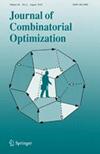论最大阶数为 5 的稀疏图的注入色度指数
IF 0.9
4区 数学
Q4 COMPUTER SCIENCE, INTERDISCIPLINARY APPLICATIONS
引用次数: 0
摘要
如果对于路径或三角形的任意三条连续边\(e_1, e_2\) 和\(e_3\),图 G 的 k 边着色(\varphi \)是可注入的,那么\(\varphi (e_1)\ne \varphi (e_3)\)就是可注入的。G 的注入色度指数 \(\chi _i'(G)\)是使 G 允许注入 k 边着色的最小 k。通过放电法,我们证明了任何最大度为 \(\Delta \le 5\) 的图,如果它的最大平均度小于 \(\frac{20}{7}\) (resp.3),就有\(\chi _i'(G)\le 12\) (resp.13),这改进了 Zhu (2023) 的结果。本文章由计算机程序翻译,如有差异,请以英文原文为准。

On injective chromatic index of sparse graphs with maximum degree 5
A k-edge coloring \(\varphi \) of a graph G is injective if \(\varphi (e_1)\ne \varphi (e_3)\) for any three consecutive edges \(e_1, e_2\) and \(e_3\) of a path or a triangle. The injective chromatic index \(\chi _i'(G)\) of G is the smallest k such that G admits an injective k-edge coloring. By discharging method, we demonstrate that any graph with maximum degree \(\Delta \le 5\) has \(\chi _i'(G)\le 12\) (resp. 13) if its maximum average degree is less than \(\frac{20}{7}\) (resp. 3), which improves the results of Zhu (2023).
求助全文
通过发布文献求助,成功后即可免费获取论文全文。
去求助
来源期刊

Journal of Combinatorial Optimization
数学-计算机:跨学科应用
CiteScore
2.00
自引率
10.00%
发文量
83
审稿时长
6 months
期刊介绍:
The objective of Journal of Combinatorial Optimization is to advance and promote the theory and applications of combinatorial optimization, which is an area of research at the intersection of applied mathematics, computer science, and operations research and which overlaps with many other areas such as computation complexity, computational biology, VLSI design, communication networks, and management science. It includes complexity analysis and algorithm design for combinatorial optimization problems, numerical experiments and problem discovery with applications in science and engineering.
The Journal of Combinatorial Optimization publishes refereed papers dealing with all theoretical, computational and applied aspects of combinatorial optimization. It also publishes reviews of appropriate books and special issues of journals.
 求助内容:
求助内容: 应助结果提醒方式:
应助结果提醒方式:


